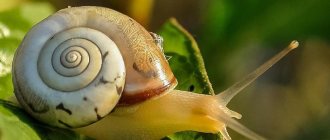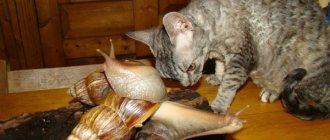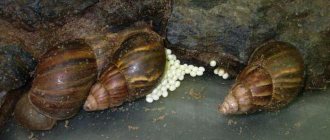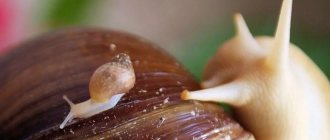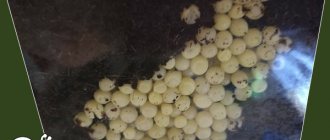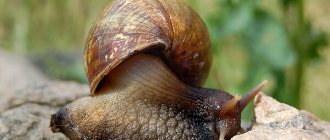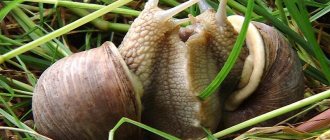Even a beginner can breed Achatina snails at home. However, before you start breeding Achatina, you need to know that a clutch can contain up to 500 eggs. It will be quite difficult for an unprepared owner to provide the necessary care for such offspring.
Babies grow quickly. As they grow, they will need to be planted in separate containers. You also need to stock up on a lot of food. Therefore, if the owner decides to breed snails, first it is necessary to prepare a place for keeping such a large number of Achatina.
Reproductive system of the Achatina snail
The African snail belongs to the class of hermaphrodites, i.e. she has male and female reproductive organs. Achatina has no division into female and male individuals. A young small snail is masculine, an adult large snail is feminine. The readiness of Achatina to reproduce is indicated by the appearance of a white tubercle on the right side of the neck.
White bump on the snail's neck
Achatina snails are oviparous mollusks, but they are also viviparous.
This is the genital organ or genital opening, since the snail is hermaphrodite. This way she signals that she is ready to reproduce. The white spot stretches out and turns into an “arrow of love” - the male genital organ. The tubercle can go deep and turn into a funnel - into the female genital organ.
The mollusk reaches sexual maturity at 7-8 months, but the worse the conditions of detention, the later its reproductive age begins.
How do I know what kind of snail I have?
Wait until your snails open the lids of their shells and examine them carefully. On the right, in the upper part of the mantle, the genital organ is noticeable in males, but not in females. It is enough to compare several pairs, and you will see that it is very difficult to confuse a male with a female.
Interesting materials:
How do standard verbs differ from non-standard verbs in Latin? What is the difference between dry cream and dry cream substitute? What is the difference between DC and AC welding machines? What is the difference between LEDs 2835 and 3528? What is the difference between properties and quality? How are temperature scales different? What is the difference between tennis and badminton? How are captions different from subtitles? What is the difference between hipster briefs and boxers? What is the difference between hips briefs?
How to create conditions for snail breeding
Proper care and comfortable living conditions allow you to grow a healthy snail and get viable offspring.
5 basic care tips
- The container containing the snail must be at least 15 liters;
- High-quality moist soil, filling 1/4 of the terrarium;
- Maintain constant temperature and humidity;
- Provide the snail with calcium and protein;
- Carry out daily and weekly cleaning of the terrarium.
A general cleaning of the terrarium or a complete replacement of the soil can serve as an incentive for reproduction in Achatina snails.
Useful tips from experts
Aquarists are convinced that nothing is easier than caring for Achatina - but only if a healthy snail has been purchased. To do this, you need to know how to choose the right tiger snails.
- You should not buy Achatina from your hands, it is better to give preference to a pet store and observe the snail for some time: how it feeds, moves, how active it is.
- Before buying a terrarium, you should check the condition of the house, check how well it is ventilated, what its volume is, and whether the air is sufficiently humidified.
- Ideally, Achatina has a pedigree, which is noted in the registration documents.
- Achatina should be smooth, have a shell without damage, and it is better to buy when it reaches 2 - 2.5 months.
Remember that a properly selected and raised individual will bring significant benefits. For example, Achatina snails can be used in cosmetology. There are many recipes for masks that contain snail mucus. Beauty salons charge a lot of money for treating skin with Achatina snail. At home, such a procedure will not cost a penny.
Which snails should you not mate?
If you want to get healthy and viable snails, then do not mate snails from the same clutch, “parents” and “children,” “brothers” and “sisters.” Healthy and large mollusks from different families are allowed to reproduce. Mate snails of the same species and variety.
It should be noted that if you want to grow a large snail, then you should not rush into reproduction, since pregnancy completely inhibits the further development and growth of the mollusk. On the Internet you can find a recommendation that it is not advisable to mate a snail until it is one year old; Achatina is actively growing and developing.
How to care for snails?
Land gastropod mollusk from the subclass of pulmonate snails. Widely distributed in countries with tropical climates, it is a highly invasive species and is a pest of agricultural plants, especially sugar cane. Currently, further expansion of the Achatina range has been stopped due to strict quarantine measures. An ongoing snail infestation in the United States was prevented. In Europe, including Russia, where Achatina survival in nature is impossible, they are often kept as pets.
How does the Achatina snail reproduce?
For mating, snails are placed in a separate container. If the snails are the same size, then fertilization occurs bilaterally, if the partners are different in size, then fertilization will be unilateral. The larger snail takes on the role of the female.
With age, the body of an adult Achatina produces more eggs than sperm.
A young snail produces more male sex cells than female ones, so for reproduction, a young one is added to adult snails.
The mating process in Achatina lasts about two hours. They gently touch their genitals, crawl and kiss each other. Whirling in such a love dance, sperm exchange and fertilization occur. Sperm is stored in the body of the mollusk for more than two years; under favorable conditions, the snail can lay eggs every month.
Caring for a pregnant snail
Snail pregnancy lasts differently for different species of Achatina, on average from one to two weeks. The snail then resolves, laying 50 to 300 eggs.
Pregnancy in an Achatina snail takes a lot of strength and energy; often after mating, the mollusks become inactive and sleep more buried in the ground. The snail stops growing and forming. These days you need to provide a sufficient amount of calcium, this can be food chalk, sepia or calcium mixtures. Feed the pregnant Achatina grain mixtures, vegetables and protein supplements. See feeding recipes here. A balanced diet will allow the birth of healthy offspring.
A week after fertilization, several eggs can be seen in the breathing hole on the side of the snail. This is a future clutch that will hatch in two weeks. The Achatina snail lays a clutch of eggs in the ground, but there are cases when the clutch is scattered over the surface of the ground.
Feeding the Achatina snail
It is better to feed as food is eaten and dried and remove any leftovers. Achatina eats vegetables, fruits and herbs, but in nature they do not refuse meat. Usually in captivity they are fed cabbage, carrots and cucumbers, but it is preferable to give them a more varied diet. This is necessary first of all so that at any moment you can switch to another available type of food. It is known that snails have certain food preferences, including many who prefer cucumbers and lettuce to other foods and, if they are fed only cucumbers from childhood, they often refuse to eat anything other than them, which can cause some inconvenience. Large snails can be given whole cores; they process food waste surprisingly quickly. Soft foods should be given only for a short period of time, otherwise they will flow and spread across the soil, causing it to become contaminated. It is generally not recommended to give soft foods to small snails. There was a case when snails buried themselves entirely in a banana and suffocated there. It is better to give very small newborn snails greens, grated carrots, and after a few days lettuce and an apple.
Can:
Fruits: apple, apricots, pineapple, avocado, bananas, pear, wild strawberry, strawberry, cherry, mango, papaya, plums, bunch of grapes, figs, watermelon, melon.
Vegetables: pumpkin, rutabaga, zucchini, broccoli, champignons, lettuce, cucumber, potatoes (boiled), carotel carrots, red peppers, celery, spinach, tomato, cabbage leaves.
Beans, peas (cooked or fresh), oatmeal.
Other: mushrooms, meadow plants/trees, nettles, daisy flowers, elder flowers, clover, dandelion, plantain, yarrow, sprouted oats, alfalfa, fruit tree blossom (apple, apricot, peach), bread (softened), milk (powdered) or natural), dairy/lactic acid products (without sugar, salt, spices), minced meat (minced meat, raw or boiled meat), egg (boiled), compound feed, meat and bone meal, peanuts (chopped), vegetable and meat baby food, gammarus.
It is important that the plants are not picked within the city, factories or enterprises, wastewater, or landfills. After you bring it home, rinse thoroughly in warm water!
You can’t (very important!):
Spicy, salty, sour, sweet, smoked, fried, pasta, potato eyes.
Laying eggs
The eggs of the Achatina snail are white, oval in shape, about 4-6 mm, enclosed in a calcium shell. The number of eggs in a clutch increases by several dozen with each subsequent clutch and can reach 400 pieces.
You should not touch snail eggs with your hands if you want to get offspring. The warmth of our hands is destructive for them.
How to care for snail eggs
Prepare a small container and add a layer of moist soil to the bottom. Then use a spoon to dig up the masonry and move it to a container. Cover the top with soil and moisten it. Try to avoid temperature fluctuations (26-28 degrees) and drying out of the soil. After 7-10 days, small snails will hatch from the eggs. Read more about snail masonry here.
False masonry in Achatina
The first clutch of snails is a trial one, i.e. unfertilized, it contains no more than 10-15 eggs. They are translucent and not enclosed in a shell. That's why snail breeders call them fat eggs.
A false clutch is a harbinger of a real one if the snail has a pair. Often fat eggs are laid by lonely Achatina. If you do not plan to reproduce Achatina snails, then it is safer to freeze all clutches. Cases of self-fertilization in African snails are common. Today, snail caviar, which can be prepared at home, is gaining great popularity among gourmets.
Egg care
Achatina snail eggs are white and oval in shape, surrounded by a calcium layer. The number of testicles increases each time, and the first clutch may be small. You cannot touch the clutch with your hands, otherwise the mollusks will die, but you can carefully lay the eggs with a spoon if they are scattered on the ground. Not all eggs will be viable, and some of the eggs laid will be empty. The soil under the masonry should be moderately moist and the temperature should be 28C. If the number of eggs exceeds expectations, some are frozen or boiled to destroy them.
After the tiny Achatina hatches, they remain under the substrate, and only after a couple of days do they crawl out into the light. The baby eats the shell. There is no need to resettle baby and adult mollusks, as snails are friendly towards their offspring. However, as soon as the descendants reach sexual maturity, the pets will still have to be seated, so as not to get a new portion of babies.
Achatina snails easily and willingly reproduce at home, and caring for eggs and pregnant snails is not at all difficult. However, having decided to breed shellfish, you should carefully monitor the health of your pets and the number of eggs, because snails can quickly fill the entire terrarium. With proper care, you can achieve a long life expectancy.
How pregnancy affects snail health
Most often, in the natural habitat, pregnancy in Achatina occurs without complications, but in home conditions, unforeseen difficulties are possible.
- Pregnancy inhibits the growth and development of mollusks
- The formation of egg clutch consumes calcium and protein reserves;
- The snail shell becomes thinner, exfoliates and becomes deformed;
- It hibernates if the snail is young and small in size.
Before you start breeding Achatina snails, you must clearly understand that several hundred snails hatch from one clutch, which require a large terrarium, proper care and nutrition. Read about keeping small Achatina. African snails grow quickly and are not so easy to sell or house, and the more snails, the higher the costs. Therefore, breeding snails in order to admire the babies is stupid and imprudent.
Does a pregnant snail need special conditions of maintenance and nutrition?
A pregnant snail's health often deteriorates.
It happens that after the first clutch the mollusk stops developing. And if there is growth, it is very slight. In addition, during this period she needs a catastrophically large amount of calcium. After all, eggshells and shells of snails are formed from maternal reserves. In this regard, a pregnant snail may begin to delaminate and crack its shell. In this case, special nutrition will be required. First of all, we are talking about a sufficient supply of mineral supplements with calcium.
These include:
- chalk;
- sepia;
- cottage cheese;
- milk;
- calcium tablets;
- ground egg shells.
Breeding conditions for Achatina snails
Achatina is at the peak of its sexual maturation when the snail reaches six months of age. At this time, a small white bump appears on the animal’s neck - this is the genital organ through which the snail’s eggs are subsequently laid. Therefore, do not worry if you suddenly find such a tubercle in your pet, this is just a sign that Achatina is ready to give birth. These mollusks are hermaphrodites by nature, and the role of the female is played by a larger and stronger individual, which is definitely worth taking into account when mating.
Choosing a habitat
For successful mating, it is necessary to create the most favorable conditions for the mollusks. One important factor is the choice of terrarium size. It should be large enough so that both Achatina have enough space in it. It should also be high, since the bottom of a low dwelling has a fairly large area, which contributes to unwanted evaporation of moisture and drying out of the soil.
Important conditions for reproduction are temperature and humidity.
It is very important to monitor the temperature inside the terrarium. It should remain unchanged within 25-30 degrees above zero. It is this factor that determines the duration of pregnancy and the period of egg development, so the microclimate in the terrarium should be warm and humid. If the room is cool, you can install additional heating for the Achatina. It can be an ordinary lamp, but you should be careful and not place it close to the glass, otherwise the mollusk may get burned. As for humidity, to maintain it within 60-70%, the soil must be irrigated with warm, settled water using a spray bottle.
Taking into account all the subtleties of sexual development, and creating the necessary, comfortable conditions for the reproduction of snails, you can confidently count on their healthy and viable offspring.
Effect of calcium on shellfish
Snails need calcium to build their shells. Calcium is a very common chemical element.
Lack of calcium in the snail's diet leads to curvature and deformation of the shell. The snail shell becomes softer due to lack of calcium; it is not protected from the environment. Since all internal organs are attached to the walls of the shell, any damage to it can lead to improper functioning of the organs or death. A mollusk that does not receive calcium from food, as a rule, lags behind in development: shell growth is disrupted or stops altogether, and puberty fails.
In order to prove how important calcium is for snails, I conducted an experiment.
Two groups of snails of the same age and species were taken and placed in the same conditions, but they were fed differently: some with food with added calcium, others with its complete absence.
Soon the snails of the second group stopped growing. It follows from this that calcium is indispensable for mollusks.
Snails kept in captivity receive calcium from sepia, eggshells, feed chalk, shell rock, gammarus, etc. For a more effective result, calcekashes are made. Calcekasha is a nutritious mixture made from various cereals with the addition of various sources of calcium; This product is served both dry and boiled.
African domestic snails mating
During the first 6-7 months of life, mollusks actively grow and accumulate vitality to reproduce healthy offspring. At home, for normal development, pets need a comfortable temperature of 25-28 degrees, constant humidity up to 80%, a properly selected diet of fresh vegetables and fruits, and mandatory protein and calcium-containing mineral supplements.
If all conditions are met, six months after birth the mollusks will be ready to mate. The first sign of readiness for “intimate relationships” is a white bulge that appears on the right side of the gastropod’s head.
How do snails reproduce?
Reproduction of Achatina, like other species, begins with mating games. Individuals court each other, rub their heads and bite their necks. A smaller snail can climb onto the shell of a larger snail and settle there for several hours.
The genital organs of Achatina protrude and connect with each other. During the process of snail mating, fertilization occurs through penetration into the head cavity.
Mating of snails can last 2-3 hours, and sometimes longer. At this moment, mating Achatina should not be disturbed or separated. Otherwise, you can permanently damage the fragile reproductive system of mollusks.
Preparation for reproduction
In the Achatina snail, reproduction occurs only if the aquarium or terrarium meets certain requirements. Despite the fact that Achatina are hermaphrodites, they need a partner in order to mate. To reproduce, a pair of Achatina must be moved to a separate container.
In order to breed healthy and full-fledged offspring, you need to create the following living conditions for mollusks:
- the size of the aquarium must be at least 15 liters;
- no temperature changes, it should stay around 27–28 degrees;
- It is recommended to cover the bottom of the aquarium with 100 mm thick damp coconut soil;
- for pregnant Achatina, as well as after laying eggs, add calcium to food;
- The terrarium must be kept clean.
The following is used as a supplement containing calcium:
- chalk stone;
- mineral stone;
- sepia;
- small shell rock.
Gender of the snail
The question of determining the sex of an individual is of interest to every breeder; as stated earlier, they have no sexual differences; it is impossible to determine the sex and divide snails into male and female. Achatina cannot reproduce alone, without a partner; a companion is needed for mating. The eldest large individual becomes the female. This is due to the fact that pregnancy requires a lot of physical strength, therefore, the strongest representatives are selected in order to ensure healthy offspring.
Stimulation of reproduction
Stimulating a mollusk to reproduce consists primarily of organizing all the necessary conditions related to preparation for mating. The terrarium should be thoroughly washed and cleaned; if the soil is dry and its thickness does not reach 10 cm, then it should be replaced. The soil must be clean. Artificial ponds should be temporarily removed from the terrarium. It is also important to make sure that only healthy Achatina mates.
Which Achatina snails cannot be mated?
- mollusks from the same clutch;
- snails that grow quickly.
Mating of individuals from the same clutch can cause various mutations and deviations in the development of future offspring.
If it is noticed that the mollusk and the shell are actively growing and increasing in size, then mating should be postponed. This process can occur up to the age of 1 year.
Achatina snail eggs
After mating, both snails received the necessary cells for fertilization. Theoretically, two individuals can become mothers and create a clutch of Achatina. But in practice, the role of the female is taken over by a larger and stronger individual, which was able to accumulate vital energy for procreation.
Small, fragile mollusks are not simply given a period of gestation.
Two weeks after mating, the pet will have “eggs”. These are future snail eggs that are visible through the breathing hole under the shell.
For 12-14 days, the female bears eggs, and then burrows into the ground to create a clutch of Achatina and place future children in a secluded place. The white spot on the head, which serves as a mating hole, now serves as an oviparous organ. The eggs of Achatina snails are smooth and slippery; they easily move inside the female’s body and fly out into the ground.
The clutch of Achatina looks like a scattering of white translucent pearls. The beads are small, up to 5 mm in diameter, and shaped like oval chicken eggs. Beginner breeders ask how many eggs hatch from a female's body after her first pregnancy? According to the owners' observations, the mother first lays two dozen fatty eggs. They are empty and serve as food for future babies. And then, within a few hours, it can lay from 100 to 400 small pearl eggs.
Peculiarities of snail reproduction
The reproduction process of land and aquarium mollusks is slightly different.
In nature
At puberty, mollusks develop a white tubercle on the right side of the neck. This is how snails signal their readiness to reproduce. Mating occurs through it. The copulatory organ can be male (then the white spot stretches out) and female (goes deeper, turning into a funnel).
Snails breed once a year, usually in the spring after hibernation. During the courtship stage, the couple touches each other with their tentacles. Then they are connected by the soles, moistened with mucus and come into contact with the genitals. After mating games, during copulation, the mollusks stick calcareous needles into each other’s body - “arrows of love.” At this time, fertilization occurs. The process is slow and takes several hours. During the rainy season, the number of newborns increases.
After the exchange of spermatophores, the mollusks disperse. They can wear them for a whole year without laying eggs. Typically, the parents develop an egg capsule (a shell-covered container of eggs). It dissolves during laying.
The individual performing the female role lays eggs in a hole or under a selected plant. The quantity can be 30-40 pieces or more than 100-300, and in some varieties up to 500-600. Then the snail covers the nest with earth and leaves this place. Often eggs are destroyed by insects, beetles, and worms. After three weeks, small snails appear from the remaining ones. Without a shell, they live underground and eat with their yolk sac. After a few days, the babies come to the surface and feed on young leaves.
At home
Land species of mollusks are grown in special terrariums.
Achatina is a common African snail; it is used in cosmetology. In nature, its shell is up to 30 cm, in captivity – 20 cm.
The mollusk matures in 6 months. For reproduction you need a high capacity, a temperature of +25...+30 °C and a humidity of 60-70%. Coconut or orchid substrate, moss are placed at the bottom, combined with sand and soil.
The role of the male, as in other species, is performed by a larger individual. In nature and at home, snails begin mating games with courtship; they bite each other’s necks and rub their heads. The small individual climbs onto the large one and settles there. The copulation process lasts several hours. The snails should not be disturbed at this time. The female bears the future offspring for 2-3 weeks, and then burrows into the ground and creates a clutch of 20-300 eggs there.
Owners usually sort out the eggs and leave the largest, viable ones, white with a yellowish tint. Babies are born depending on the conditions, usually within 15-30 days.
Arhahatina is also a huge snail, but differs in its shell, which is rounded at the end and has a grooved or crocodile-shaped leg. It requires a temperature of +23...+28 °C and high humidity of 80%. Maturity occurs at 12-17 months. Egg development takes 28-40 days. The masonry is 3-12 pieces depending on the type.
Limicolaria are decorative snails of different colors. They are demanding of maintenance, just like archaic animals; if they feel uncomfortable, they hibernate. Capable of reproduction after 9 months. Lays about 300 eggs, hatchlings appear after 3 weeks.
Basic requirements for a comfortable life
Large African clams require high-quality maintenance and care. Therefore, among the requirements for keeping Achatina are a properly selected house and an optimal temperature in it, which will not allow the mollusk to hibernate and will not lead to increased metabolism.
The soil should be poured in a layer up to 5-7 cm, and for the tiger snail the height should be 11-16 cm, since this species prefers to bury itself entirely in the substrate. The listed requirements for care and maintenance are basic, but not the only ones that hives need.
Selection of capacity
Read more about different types of terrariums and the requirements for them in our article.
Large snails are incredibly inquisitive and love to get to know the outside world, which is outside their house. They are smart, but not smart enough to understand how dangerous traveling on their own is for their lives.
This is what happens when the volume of the terrarium is not enough. Here it’s not just cramped conditions – it’s definitely offensive!
For safety reasons, the aquarium is covered with a lid on top. Its role can be assigned to a piece of transparent “breathable” - that is, having holes - plastic. If the owner plans to leave, it is important to make sure that Achatina cannot lift the lid and get out.
Heating and ventilation
African land snails prefer a warm climate - partly this fact explains why Achatina still does not spontaneously reproduce in Russia. Here, the heat-loving African snail is simply cold. The temperature in the aquarium must be adjusted within 22-27 degrees with a plus sign.
Ventilation also plays a big role in creating good living conditions for shellfish. They provide balance between humidity and temperature.
Selection and arrangement of substrate (soil)
Domestic Achatina, like their wild relatives, love to burrow into the ground. Therefore, the base of the house needs to be thicker, from 11 cm or more. Soil requirements: looseness and good ventilation. In the future, Achatina will lay eggs in it.
A good option is coconut substrates or soil for flower pots, which is sold in any specialty store. The only condition is the absence of fertilizers and other harmful chemicals.
Buy dry coconut substrate for snails on Aliexpress - it's cheaper and easier.
Maintaining optimal humidity
The content, as already mentioned, requires certain temperature and humidity regimes suitable for snails to live. These mollusks are tropical animals, and the tropics are humid all year round. Accordingly, the higher the air humidity, the easier life is for Achatina. Acceptable values are 80-90%. But everything is determined individually.
Dryness can be eliminated by moistening the soil and placing a bowl of water. The snail will happily swim in the bowl. The only thing: the bowl must be held steady, otherwise the pet will knock it over or choke. From time to time, the water in the bowl must be renewed.
Decorating and arranging the terrarium
Mollusks react to light, so it matters for keeping whether it is light or dark outside the window. Animals are most active at night, and during the day they burrow into the substrate and other places. Decorative elements can be used as such nooks:
- coconut shell;
- decorative stones;
- driftwood;
- grass or fern.
The Madagascar snail will appreciate a plant such as ivy. It will serve Achatina not only as shelter, but also as food. However, Achatina will not disdain ferns and other types of plants either.
Handle your pet carefully
Despite their size, large Achatina are very vulnerable. Neglect and careless handling of shellfish can result in damage to the shell. In some cases, damage to the shell of giant Achatina is corrected with special ointments such as propolis, as well as with epoxy glue and enhanced calcium-containing additives. But in critical situations, damage to the shell leads to death.
Caution must be observed at any time when the Achatina snail is sent into the hands of the owner and other people.
Feed vegetables and greens once a day
Caring for adult Achatina requires a variety of products. After all, gastropods eat almost everything. But preference should be given to plant-based foods. The best option is vegetables.
Green is allowed, yellow is allowed with caution, and red is not allowed at all!
What to feed Achatina? Here is a sample list of products:
In addition to the above, the African snail's diet should include calcium and supplements containing it - for example, ground shells or chalk. Egg white, chicken or animal meat are suitable as protein. But you should give it occasionally, without abusing it.
It is enough for a young snail to eat once a day, but adults can eat once every couple of days.
Since the snail is an animal that is active at night, it is best to feed it in the evening.
Controlling the appearance of masonry
An adult Achatina can lay up to a thousand eggs per year or more at home. At one time, the mollusk lays a clutch of 250-300 eggs. From this amount, after 2 weeks, an offspring of 6-7 mm in size appears.
But in order for Achatina to lay eggs, she needs a partner. Although most land snails are hermaphrodites, they cannot reproduce without a partner. But even if Achatina is now kept alone, but has had contact with another snail, it can lay a clutch. Read more about reproduction in our article. In addition, the gastropod must reach maturity. Usually it occurs no earlier than six to seven months after birth.
Keep it clean
Another point regarding the question of how to keep Achatina in an apartment is related to the cleanliness of her home. The content assumes that the mollusk will be provided with its own house - at home, an aquarium or other tank is used in its role.
Beautiful snail - healthy!
Achatina snails are considered not too vulnerable to infections and diseases. But due to incorrect conditions of detention, they can get sick.
Most often, improper snail care is as follows:
- overheating or hypothermia of Achatina;
- the aquarium is of insufficient volume;
- ignoring the procedure for moistening the soil;
- lack of air conditioning and ventilation;
- insufficient calorie diet with low protein and calcium content.
Good care and careful monitoring of Achatina snails at home will help prevent diseases. Animals need to be provided with supplements containing calcium, feed should be selected wisely and preventive measures should be taken: cleaning the aquarium, bathing the shellfish.
How to create conditions for snail breeding in an aquarium
Mollusks reproduce under certain conditions:
- Water temperature +25…+28 °C, without sudden changes.
- The need for sufficient food.
- Calcium is added to the diet.
- Do not add water to the very top.
- Remove leftover food from the cubs.
- Change the water once a week.
In hermaphrodites, the male is usually the larger individual, the female is the smaller one. The age for reproduction is at least 12 months. The eggs underwater are covered with yellow mucus, on the surface - milky, then pink.
Sometimes processes of self-fertilization, without a partner, are also observed.
There is no need to care for the larvae, just clean the aquarium and monitor the ammonia level, it should be zero. Babies appear in 15-20 days. If this does not happen, the masonry is broken, it happens that there are no fry or most of them die.
How to regulate the number of snails in an aquarium
Despite the benefits of shellfish, you need to monitor their quantity. Too many snails pollute the water, spoil plants and eat fish eggs. Owners resort to several methods of getting rid of shellfish:
- Mechanical - young animals are collected, crushed and fed to other inhabitants of the reservoir.
- Thermal - the masonry is frozen, crushed and fed to fish and snails.
- Biological - they keep predatory fish (cichlids, barbs, tetraodons) or helenas, which eat other mollusks and caviar.
To catch shellfish, traps are used - a cabbage leaf scalded with boiling water is placed on the bottom, and in the morning snails will gather on it. Or they take a plastic bottle and make a hole for gastropods so that fish cannot get in.
There are also chemical and electrical methods of getting rid of snails, but then the entire aquarium with other inhabitants will suffer. Otherwise, they breed snails that are unable to reproduce in fresh water.
Mr. Tail recommends: the most common aquarium snails
There are many varieties of aquarium snails, including omnivores and predators, which are bred separately. They come from Southeast Asia, Thailand, and Africa. In nature, they live in ponds, lakes, streams, and rivers.
| View | Description |
| Reels | Freshwater mollusks do not require special care and live even in dirty water. They reproduce very quickly, lifespan is 1 year. The shell looks like a narrow, twisted spiral with 4-5 turns. Color – bright red, brown. Reach 3.5 cm in nature, 1 cm in an aquarium. They crawl on surfaces and in water and live for one year. They eat dead algae and destroy bacterial film. |
| Physidae | Hermaphrodites, measuring 17 mm, in an aquarium 8-9 mm, often bring them in accidentally, along with plants. Ovoid shell up to 3-5 whorls, pink, brown, yellow-brown color. They eat leftover food and green deposits on glass. But they are useful only in small quantities. They live up to 2 years. |
| Ampoules | Peaceful snails, kept with fish, eat a lot, grow up to 15 cm. Yellow, also blue, white, black, blue are more common. They live for 2 years. |
| Melania | Viviparous, dioecious, gray mollusks live in the soil in the aquarium, loosen it and improve water circulation, appearing only at night. The carapace is in the form of a cone, 3 cm long, has 6-7 whorls. Lifespan – 2 years. |
| Helena | Predators love soft ground. Yellow with dark or black stripes. Diverse, reproduce slowly. They feed on snails. Dimensions 2 cm. Lives 2-4 years. |
| Tylomelania | Viviparous, beautiful, yellow, orange, olive, black, distinguished by an unusual structure. The mouth part is similar to the proboscis of a tapir. The body is bright yellow. Demanding on content. Lifespan – 2-3 years. |
| Neretina | They are heterosexual, similar to the Colorado potato beetle, small, clean the aquarium, but their eggs there are often not viable, they live for 2-3 years. Adapts poorly to new conditions. |
| Maryse | Up to 5 cm in size, beautiful, golden, twisted shell with dark stripes. They breathe atmospheric air, can leave the aquarium and walk around the house, are dioecious, males can be easily distinguished from females, and are omnivorous. They live from 2 to 4 years. |
| Pagodas (brothia) | A rare species, reaching 6 cm. Sensitive to the oxygen content in water. Viviparous, dioecious. They live no more than 6 months. |
Snails from natural bodies of water should not be kept at home (pond snails, meadows, pearl barley). They eat vegetation at the roots and carry diseases and pests.
